Most of the electronic goods we dispose of eventually end up in developing countries (for computers, the figure is 90%). Most of this equipment is repaired and sold on; creating jobs and allowing access to cheap IT for those who would otherwise not benefit from it. In Accra, Ghana, for example, the refurb sector provides more than 30,000 jobs, and 80% of devices are either secondhand, repaired or refurbished.

However, there is also a dark side to this story. Your mobile phone contains arsenic, lead and a host of other toxic materials that pose a threat to life when it is no longer (re)useable. If the phone is sent to landfill, these chemicals can leach into soil and groundwater. Under appropriate conditions, recycling is safe. But if the recycling is conducted by a child with no safety gear on a Ghanian rubbish tip, the consequences can be brutal. Unfortunately, the latter is common. The biggest e-waste dump in the world is just outside Accra.
This newly released Tearfund paper examines how product design standards (and in particular the EU’s Ecodesign legislation) could be used to enhance the livelihoods of those engaged in repair and recycling in poor nations, rather than endangering them. This perspective is entirely absent from the debate about these standards at present.
The paper represents our first investigation of this important issue, but we can already draw three conclusions:
1. Ambitious, open design standards could improve the livelihoods of repair and remanufacturing entrepreneurs in the Global South.
2. Restrictive standards that allow manufacturers to exert a monopoly over repair and upgrade could damage these livelihoods.
3. Restricting the use of hazardous chemicals (like those on the list of ‘Substances of Very High Concern’) could improve the health of huge numbers of children and adults currently involved in the informal recycling of electronics.
At present, design standards such as the EU’s Ecodesign measures are intended to improve the resource efficiency of products sold in Europe, which is a worthy aim. With a bit more thought, they could also be used to improve the lives of some of the poorest people in the world.
This blog also appeared on Tearfund’s JustPolicy platform.
— This feed and its contents are the property of The Huffington Post UK, and use is subject to our terms. It may be used for personal consumption, but may not be distributed on a website.